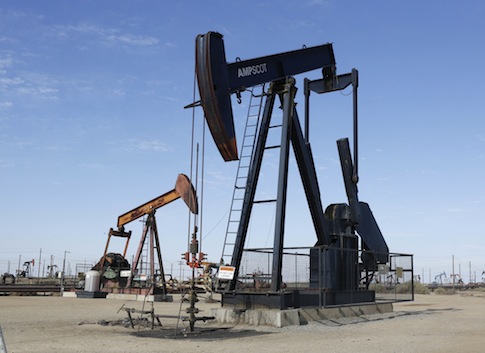The Environmental Protection Agency’s new rule restricting carbon emissions from existing power plants has Republicans and fossil fuel advocates fuming, but the regulations could end up providing a major boost to U.S. oil production.
According to the final version of the rule, released Monday, the EPA expects that carbon dioxide emitted and captured by what is known as carbon capture and sequestration technology will be sold and used for an innovative oil extraction technique that could free up oil in previously depleted wells.
The agency disputes claims, sourced to EPA’s own data, that the resulting carbon dioxide emissions will dwarf the amount sequestered for use in that process.
EPA’s rule encourages carbon-intensive power plants, particularly those that generate electricity by burning coal, to implement CCS technology. The agency has pushed back against industry claims that the technology is not yet commercially viable.
In calculating the relative costs and benefits of the rule, EPA included data on the use of sequestered carbon dioxide in a process called enhanced oil recovery (EOR).
"EOR using CO2, sometimes referred to as ‘CO2 flooding’ or CO2-EOR, involves injecting CO2 into an oil reservoir to help mobilize the remaining oil to make it more amenable for recovery," the agency explained.
Industry experts expect the increased use of CCS technology to dramatically expand EOR-induced oil production. "The market is expected to grow rapidly," according to the Environmental Leader, and CO2 flooding is expected to become more popular "as federal governments focus on carbon capture and sequestration."
EPA is bullish on EOR’s ability to boost production.
"Oil and gas fields now considered to be ‘depleted’ may resume operation because of increased availability and decreased cost of anthropogenic CO2," a previous version of its power plant rule projected.
Power plants that will be subjected to the new regulation are already preparing to sell CO2 to companies that will use it for EOR.
"There are currently 23 industrial source CCS projects in 12 states that are either operational, under construction, or actively being pursued, which are or will supply captured CO2 for the purposes of EOR," the EPA said last year.
The final rule cited a Department of Energy study to estimate potential oil production from increased use of EOR. Expanding the practice "could utilize 18 billion metric tons of anthropogenic CO2 and increase total oil production by 67 billion barrels."
EPA used that additional production as a way to offset the projected financial costs of the regulations. But according William Yeatman, senior fellow and energy policy expert at the Competitive Enterprise Institute, it could also significantly offset CO2 emissions reductions achieved through CCS technology.
Yeatman pointed to EPA data showing that burning a barrel of crude oil produces an average of 0.43 metric tons of carbon dioxide. The additional 67 billion barrels it estimates could be recovered through expanded EOR could therefore be expected to generate roughly 28.8 billion metric tons of CO2, significantly more than the 18 billion metric tons sequestered and used in the EOR process.
Put another way, each metric ton of carbon dioxide sequestered and used in the EOR process produces enough oil to emit an additional 1.6 metric tons of carbon dioxide. Yeatman called that "a HUGE problem with EPA’s proposal."
The rule "completely fails to take into account the expanded carbon footprint of the oil industry caused by its power plant rule," Yeatman wrote on Monday.
"To the extent that CCS prompts new EOR operations, or if it replaces existing CO2 streams that would otherwise be emitted, it is a net increase" in emissions, he said in an email.
EPA disputed those calculations in an emailed statement. An agency spokeswoman said it "thoroughly considered comments regarding life cycle emissions of captured CO2 used for enhanced oil recovery."
"Recent scholarly work indicates that using CCS from coal-fired power plants as a source of CO2 for EOR results in about 31% lower net CO2 emissions per barrel of oil recovered compared to natural source CO2," the statement said.
However, Yeatman’s calculations did not rest on a comparison of the sources of CO2 used in the EOR process. Rather, he says, the CO2 emitted as a result of EOR-induced oil production would result in a rise in emissions.
Commonly used EOR techniques mean that CO2 used in the process can often be recycled and reused to extract more crude oil. As EPA explains, "The crude oil and CO2 mixture [extracted from an EOR well] is then recovered and sent to a separator where the crude oil is separated from the gaseous hydrocarbons, native formation fluids, and CO2."
"The gaseous CO2-rich stream then is typically dehydrated, purified to remove hydrocarbons, re-compressed, and re-injected into the reservoir to further enhance oil recovery."
As a result, while coal combustion is more carbon-intensive than the burning of EOR-derived oil, each unit of CO2 used in the process can extract enough oil to produce more CO2 than was used in that extraction process.
